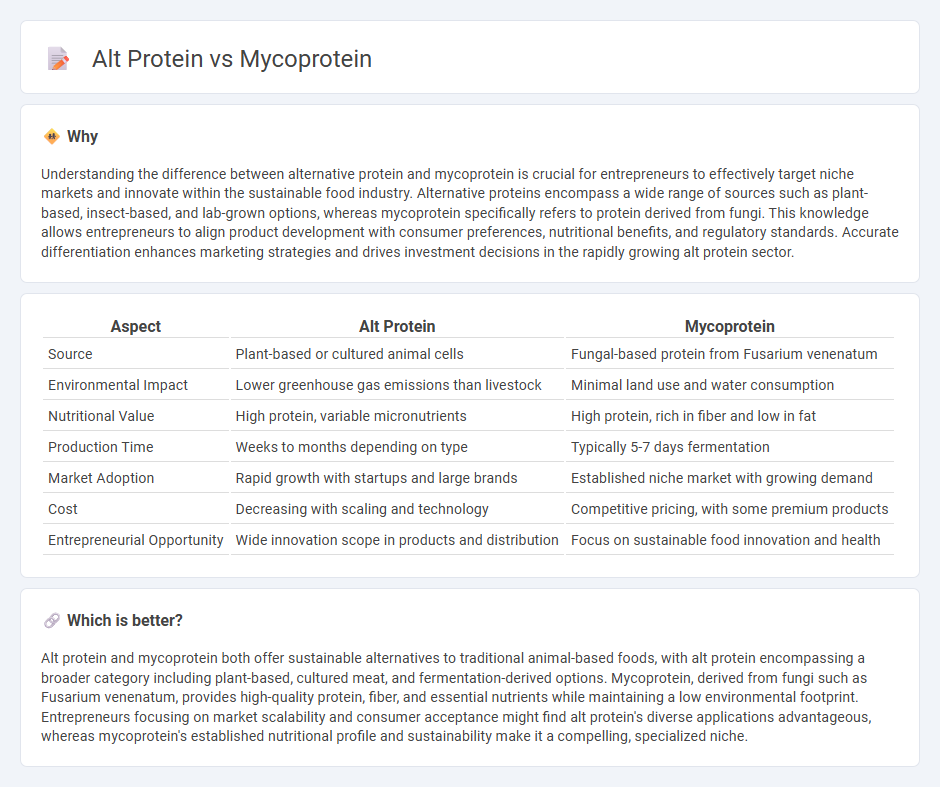
Entrepreneurship in the alternative protein sector focuses on innovating sustainable food sources like plant-based alternatives and mycoprotein products derived from fungi. These protein sources offer eco-friendly solutions to traditional animal agriculture, addressing environmental challenges with lower carbon footprints and efficient resource usage. Explore the breakthroughs and market potential driving the future of food innovation.
Why it is important
Understanding the difference between alternative protein and mycoprotein is crucial for entrepreneurs to effectively target niche markets and innovate within the sustainable food industry. Alternative proteins encompass a wide range of sources such as plant-based, insect-based, and lab-grown options, whereas mycoprotein specifically refers to protein derived from fungi. This knowledge allows entrepreneurs to align product development with consumer preferences, nutritional benefits, and regulatory standards. Accurate differentiation enhances marketing strategies and drives investment decisions in the rapidly growing alt protein sector.
Comparison Table
| Aspect | Alt Protein | Mycoprotein |
|---|---|---|
| Source | Plant-based or cultured animal cells | Fungal-based protein from Fusarium venenatum |
| Environmental Impact | Lower greenhouse gas emissions than livestock | Minimal land use and water consumption |
| Nutritional Value | High protein, variable micronutrients | High protein, rich in fiber and low in fat |
| Production Time | Weeks to months depending on type | Typically 5-7 days fermentation |
| Market Adoption | Rapid growth with startups and large brands | Established niche market with growing demand |
| Cost | Decreasing with scaling and technology | Competitive pricing, with some premium products |
| Entrepreneurial Opportunity | Wide innovation scope in products and distribution | Focus on sustainable food innovation and health |
Which is better?
Alt protein and mycoprotein both offer sustainable alternatives to traditional animal-based foods, with alt protein encompassing a broader category including plant-based, cultured meat, and fermentation-derived options. Mycoprotein, derived from fungi such as Fusarium venenatum, provides high-quality protein, fiber, and essential nutrients while maintaining a low environmental footprint. Entrepreneurs focusing on market scalability and consumer acceptance might find alt protein's diverse applications advantageous, whereas mycoprotein's established nutritional profile and sustainability make it a compelling, specialized niche.
Connection
Alt protein and mycoprotein represent innovative sectors within entrepreneurship focused on sustainable food solutions. Startups leverage mycoprotein, a protein derived from fungi, to develop alt protein products that reduce reliance on traditional animal agriculture. This convergence drives market growth by addressing environmental concerns and meeting increasing consumer demand for plant-based and alternative proteins.
Key Terms
Fermentation
Mycoprotein, derived from filamentous fungi through fermentation, offers a sustainable alternative protein with high fiber content and essential amino acids, differentiating it from many plant-based alternative proteins. Fermentation enables efficient biomass production with lower greenhouse gas emissions and land use compared to traditional animal agriculture. Explore the latest advancements in fermentation technology to understand the future potential of mycoprotein in the alternative protein market.
Sustainability
Mycoprotein, derived from fungi, offers a highly sustainable alternative to traditional animal proteins due to its low water usage, minimal land requirements, and reduced greenhouse gas emissions compared to alt proteins like plant-based and cultured meats. Lifecycle assessments indicate mycoprotein's efficiency in resource utilization supports circular economy goals and significantly lowers the environmental footprint of protein production. Explore the comparative sustainability metrics of mycoprotein and alternative proteins to understand their impact on future food systems.
Product Differentiation
Mycoprotein, derived from fungi such as Fusarium venenatum, offers a high-protein, fiber-rich alternative with a meat-like texture and low environmental impact, distinguishing it from plant-based alt proteins typically sourced from soy, peas, or grains. Alt proteins vary widely in taste, texture, and nutritional profiles, with mycoprotein standing out for its complete amino acid profile and beneficial micronutrients like B vitamins. Explore detailed comparisons to understand which alternative protein aligns best with your dietary goals and sustainability values.
Source and External Links
What to Know About Mycoprotein - WebMD - Mycoprotein is a protein derived from the fungus Fusarium venenatum, produced through fermentation, and commonly used as a meat alternative due to its meat-like texture and nutritional profile.
Mycoprotein: The Future of Nutritious Nonmeat Protein, a ... - Mycoprotein is a nutritious meat-like protein made from Fusarium venenatum fungus, having environmental benefits such as a reduced carbon and water footprint compared to traditional meats, and potential health benefits including cholesterol management and muscle synthesis.
Mycoprotein: What It Is, Potential Side Effects, and Benefits - Healthline - Sold under the brand name Quorn, mycoprotein is a fermented fungal protein that is high in protein and fiber, low in fat and cholesterol, and serves as a popular meat substitute while carrying a low environmental impact.
 dowidth.com
dowidth.com